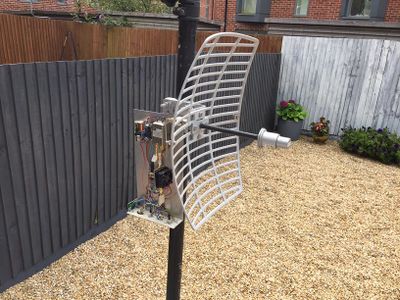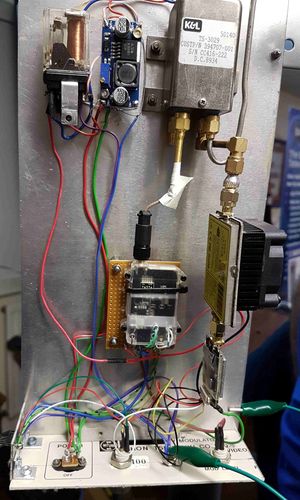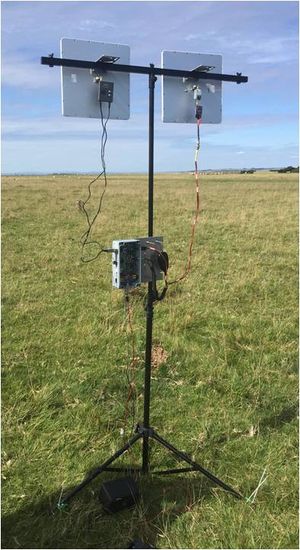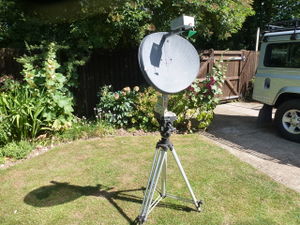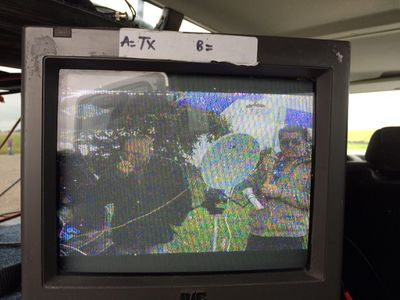5.6 GHz
Amateur TV activity on the 6 cm band is increasing due to the availability of cheap modules intended to transmit “First Person Video” (FPV) back from drones to their operators.
Frequency choice
The UK amateur band plan is shown on the RSGB website here: https://thersgb.org/services/bandplans/html/rsgb_band_plan_2017.htm
GB3KM has a licensed input on 5665 MHz and this has been chosen as the primary ATV operating frequency.
The FPV equipment receive and transmit frequencies are set using DIP switches, and most tune to this frequency but care needs to be taken when selecting equipment to make sure it does cover this frequency.
Equipment
The FPV units are widely advertised on eBay with titles similar to “Tarot 5.8G 600MW Telemetry TX/RX Combo for FPV Image Transmission TL300N” and are available at reasonable prices. The typical units are very small but have reasonable FM-TV performance with a quoted spec of 600 milliwatts out and receiver sensitivity of -80 dBm. Amplifiers are available to raise the output power to 2 watts or more.
This units are very small but do run very hot in operation and it is suggested you provide a good heatsink for both Tx and Rx
Detail of G8GKQ transceiver setup is shown here (receiver unit on left & transmitter with fan on the right)
Video equipment
Rx
The receiver will need to be directly connected to a composite video input monitor to view the received the signal - normally on a yellow phono or RCA connector. Beware of using modern flat screen monitors which have a video squelch which will not display noisy signals and just give a blue screen until they get a strong video signal.
There are a number of circuits around to defeat the squelch.
Tx
An old camcorder with a yellow phono video out socket is an ideal video and audio source for the transmitter but don't forget you will need to display your call sign to remain legal. This can be a video generator, a jpeg card reader with video out, the Portsdown system with video out or a piece of card with your call sign scribbled on it!
Antenna change over relays
The losses at 5.6GHz can be significant and care must be taken when wiring up the units to ensure RF cables are of good quality and kept to a minimum length. The surplus SMA relays often available at rallys are ideal for 5.6 GHz.
If no suitable relay is available It may be cheaper to use a separate antenna for receive and transmit as shown in the picture below.
Reverse SMA
Be aware that suplus SMA relays are almost certain to be standard SMA connectors and the 5.6GHz FPV units are reverse SMA. Adapters from reverse to standard SMA are available on ebay or other suppliers.
24v relay operation
Most of these relays are often 24v coils - use a switching regulator from ebay as shown in the above picture.
Antennas
As 5.8GHz is also used by broadband wireless networks, there is a wide choice of antennae available for use on 5.6GHz ATV. This can range from flat plates to wire mesh dishes as seen in the above pictures.
It is also possible to use a satellite mini dish with a suitable feed such as a wave guide horn to the design by G4NNS - the picture shows a Sky mini dish fed with a WA5VJB log period PCB feed (available from G4DDK).
On the air
Using dish aerials of 30 – 60 cm line of sight ranges of 80 km can easily be achieved. P5 (noise free) FM ATV pictures have been exchanged over an 138km path using the equipment pictured - the picture below shows G4COE being received over a slightly obstructed 66Km path.
Horizontal polarity has been chosen as the standard and dishes typically have a beam width of 4-8 degrees.
Activity hot spots
Know users include:
- Southern England = G8GKQ, G8GTZ, G0UHY, G8XZD, G4UVZ, G3VPF
- Dunstable area = M0SKM, G4CPE, G0WFT
- North-east = GB3KM, G1LPS, M0DTS
- Cheltenham = G0LGS, M0RKX and G4NZV (using WB audio only)
- Bolton Wireless Club = G4JLG, M0UFC, MW1FGQ, G6GVI (PW “Siren” Article)
- Hereford = G8XYJ
- Yorkshire = G8BYN
- Norfolk = G4NJJ, G8AJN and M1BKF
- Cumbria - Barrow in Furness radio Club project
